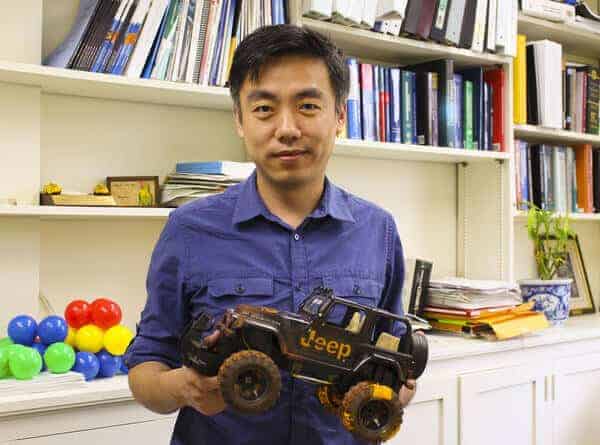A group of University of Wisconsin-Madison engineers and a collaborator from China have developed a nanogenerator that harvests energy from a car’s rolling tire friction.
An innovative method of reusing energy, the nanogenerator ultimately could provide automobile manufacturers a new way to squeeze greater efficiency out of their vehicles.
The researchers reported their development, which is the first of its kind, in a paper published May 6, 2015, in the journal Nano Energy.
Xudong Wang, the Harvey D. Spangler fellow and an associate professor of materials science and engineering at UW-Madison, and his PhD student Yanchao Mao have been working on this device for about a year.
The nanogenerator relies on the triboelectric effect to harness energy from the changing electric potential between the pavement and a vehicle’s wheels. The triboelectric effect is the electric charge that results from the contact or rubbing together of two dissimilar objects.
Wang says the nanogenerator provides an excellent way to take advantage of energy that is usually lost due to friction.
“The friction between the tire and the ground consumes about 10 percent of a vehicle’s fuel,” he says. “That energy is wasted. So if we can convert that energy, it could give us very good improvement in fuel efficiency.”
The nanogenerator relies on an electrode integrated into a segment of the tire. When this part of the tire surface comes into contact with the ground, the friction between those two surfaces ultimately produces an electrical charge-a type of contact electrification known as the triboelectric effect.
During initial trials, Wang and his colleagues used a toy car with LED lights to demonstrate the concept. They attached an electrode to the wheels of the car, and as it rolled across the ground, the LED lights flashed on and off. The movement of electrons caused by friction was able to generate enough energy to power the lights, supporting the idea that energy lost to friction can actually be collected and reused.
“Regardless of the energy being wasted, we can reclaim it, and this makes things more efficient,” Wang says. “I think that’s the most exciting part of this, and is something I’m always looking for: how to save the energy from consumption.”
The researchers also determined that the amount of energy harnessed is directly related to the weight of a car, as well as its speed. Therefore the amount of energy saved can vary depending on the vehicle-but Wang estimates about a 10-percent increase in the average vehicle’s gas mileage given 50-percent friction energy conversion efficiency. “There’s big potential with this type of energy,” Wang says. “I think the impact could be huge.”
If our reporting has informed or inspired you, please consider making a donation. Every contribution, no matter the size, empowers us to continue delivering accurate, engaging, and trustworthy science and medical news. Independent journalism requires time, effort, and resources—your support ensures we can keep uncovering the stories that matter most to you.
Join us in making knowledge accessible and impactful. Thank you for standing with us!


When a tire is being compressed and expanded the energy expenditure is not due to ground friction, but is due to internal stretching and relaxation of the rubber and plies. It is dissipated as heat. If some of this energy was harvested then the tire would either become harder, and less suitable to do its regular job, or it would need to be more flexible so as to both do its regular job and provide for energy to be harvested.
As is well-known, by raising tire pressure, there is a reduction in the dissipation of energy due to this flexure and an improvement in fuel mileage, but motorists do not normally do this because it reduces braking performance and is less safe in emergencies. So that using this method of energy collection either a) the tire will be less safe or b) the rolling friction will increase with lower fuel mileage.